Psychological Impact of Alzheimer's: An Analysis of Still Alice
VerifiedAdded on 2020/04/15
|5
|988
|146
Essay
AI Summary
This essay provides an analysis of the novel 'Still Alice,' focusing on the psychological impact of Alzheimer's disease on the protagonist, Alice Howland, and her family. It explores Alice's initial reactions to her diagnosis, her coping mechanisms, and the gradual decline in her cognitive abilities and memory. The essay examines the emotional strain on her husband, John, and the evolving relationships with her children, particularly Lydia. It also delves into the symbolic significance of the butterfly, representing Alice's life and her reflections on her condition. The analysis draws on references to highlight the themes of identity, relationships, and the challenges faced by individuals and families dealing with Alzheimer's. Desklib provides students with access to past papers and solved assignments to aid in their studies.
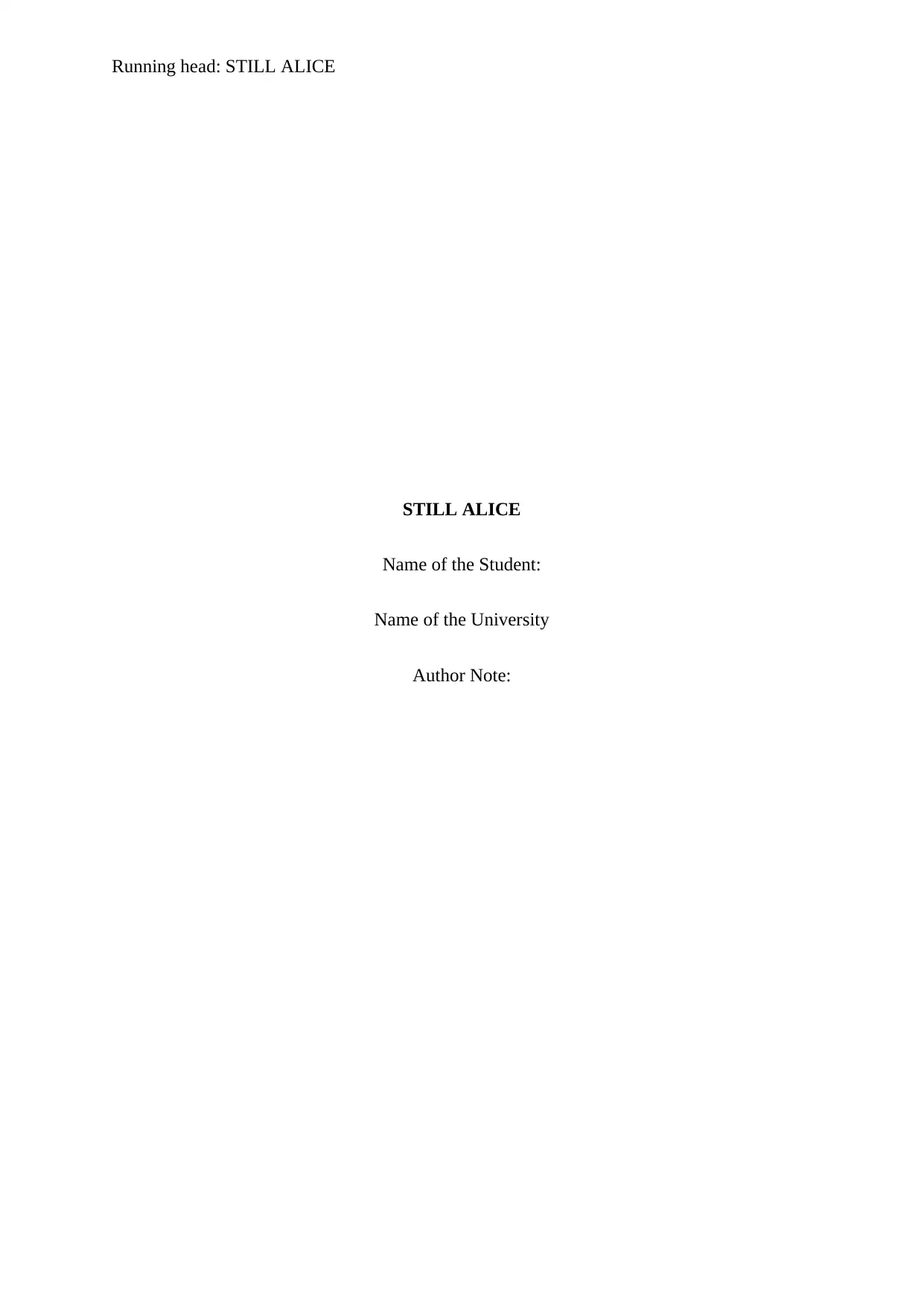
Running head: STILL ALICE
STILL ALICE
Name of the Student:
Name of the University
Author Note:
STILL ALICE
Name of the Student:
Name of the University
Author Note:
Paraphrase This Document
Need a fresh take? Get an instant paraphrase of this document with our AI Paraphraser
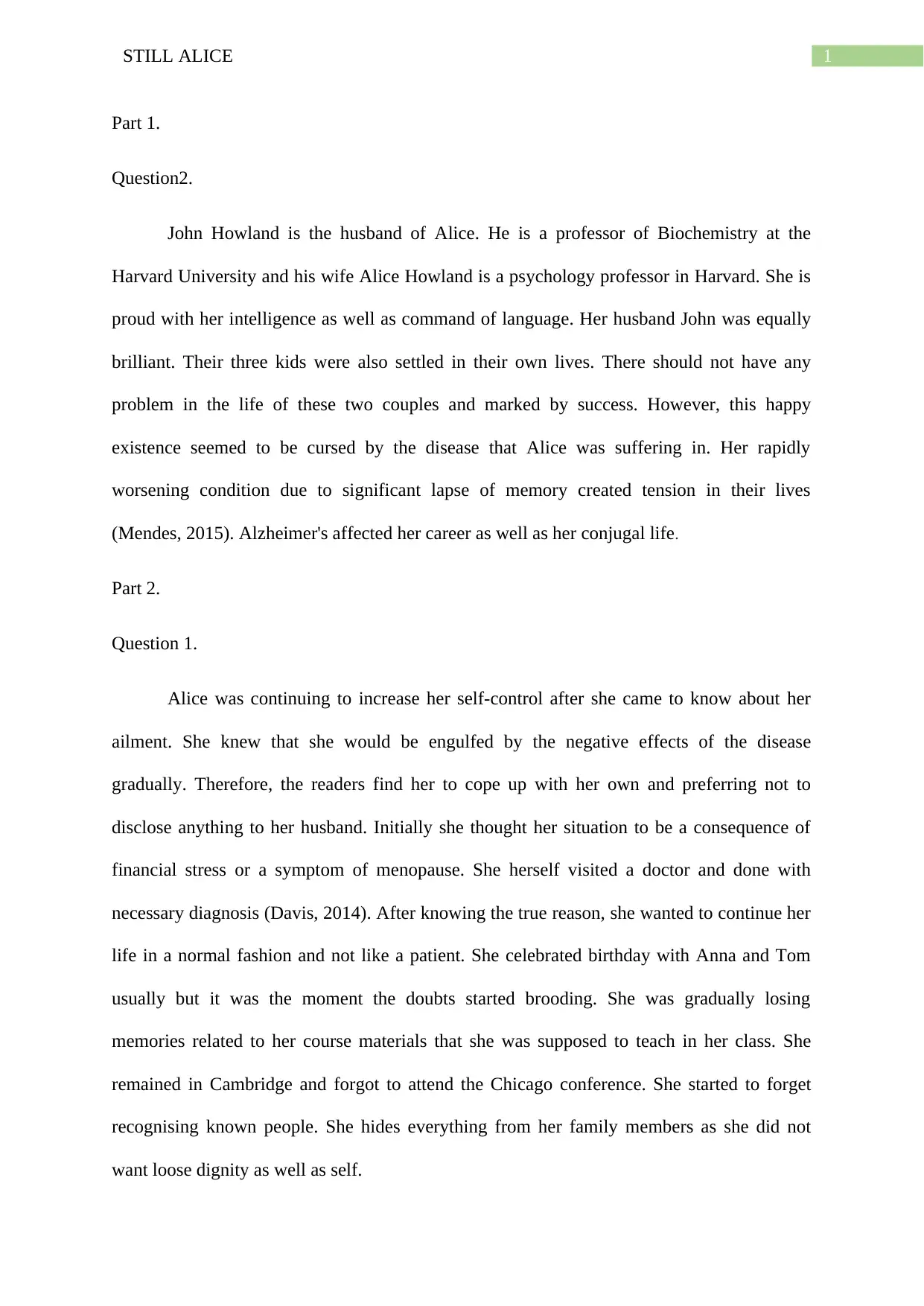
1STILL ALICE
Part 1.
Question2.
John Howland is the husband of Alice. He is a professor of Biochemistry at the
Harvard University and his wife Alice Howland is a psychology professor in Harvard. She is
proud with her intelligence as well as command of language. Her husband John was equally
brilliant. Their three kids were also settled in their own lives. There should not have any
problem in the life of these two couples and marked by success. However, this happy
existence seemed to be cursed by the disease that Alice was suffering in. Her rapidly
worsening condition due to significant lapse of memory created tension in their lives
(Mendes, 2015). Alzheimer's affected her career as well as her conjugal life.
Part 2.
Question 1.
Alice was continuing to increase her self-control after she came to know about her
ailment. She knew that she would be engulfed by the negative effects of the disease
gradually. Therefore, the readers find her to cope up with her own and preferring not to
disclose anything to her husband. Initially she thought her situation to be a consequence of
financial stress or a symptom of menopause. She herself visited a doctor and done with
necessary diagnosis (Davis, 2014). After knowing the true reason, she wanted to continue her
life in a normal fashion and not like a patient. She celebrated birthday with Anna and Tom
usually but it was the moment the doubts started brooding. She was gradually losing
memories related to her course materials that she was supposed to teach in her class. She
remained in Cambridge and forgot to attend the Chicago conference. She started to forget
recognising known people. She hides everything from her family members as she did not
want loose dignity as well as self.
Part 1.
Question2.
John Howland is the husband of Alice. He is a professor of Biochemistry at the
Harvard University and his wife Alice Howland is a psychology professor in Harvard. She is
proud with her intelligence as well as command of language. Her husband John was equally
brilliant. Their three kids were also settled in their own lives. There should not have any
problem in the life of these two couples and marked by success. However, this happy
existence seemed to be cursed by the disease that Alice was suffering in. Her rapidly
worsening condition due to significant lapse of memory created tension in their lives
(Mendes, 2015). Alzheimer's affected her career as well as her conjugal life.
Part 2.
Question 1.
Alice was continuing to increase her self-control after she came to know about her
ailment. She knew that she would be engulfed by the negative effects of the disease
gradually. Therefore, the readers find her to cope up with her own and preferring not to
disclose anything to her husband. Initially she thought her situation to be a consequence of
financial stress or a symptom of menopause. She herself visited a doctor and done with
necessary diagnosis (Davis, 2014). After knowing the true reason, she wanted to continue her
life in a normal fashion and not like a patient. She celebrated birthday with Anna and Tom
usually but it was the moment the doubts started brooding. She was gradually losing
memories related to her course materials that she was supposed to teach in her class. She
remained in Cambridge and forgot to attend the Chicago conference. She started to forget
recognising known people. She hides everything from her family members as she did not
want loose dignity as well as self.
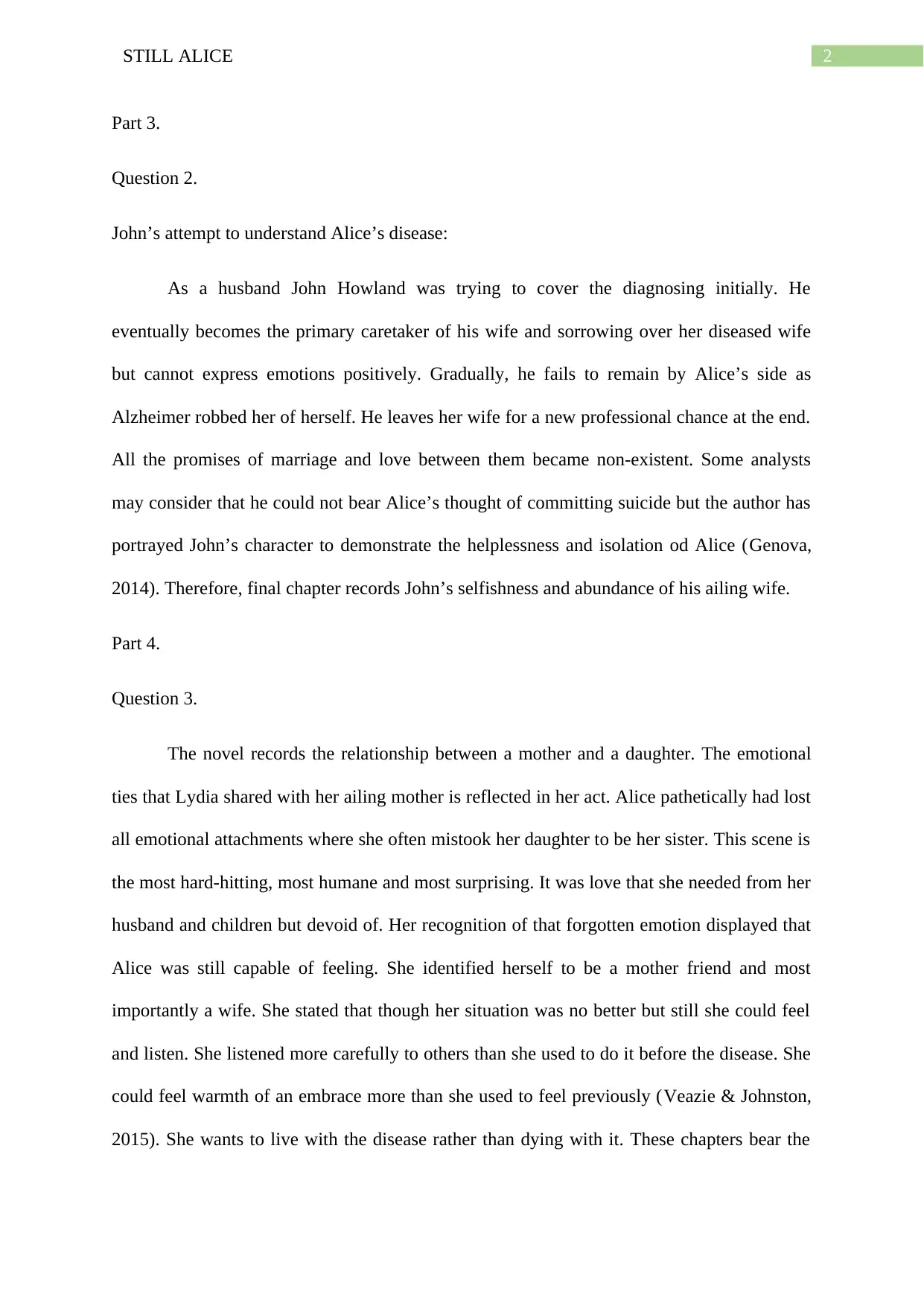
2STILL ALICE
Part 3.
Question 2.
John’s attempt to understand Alice’s disease:
As a husband John Howland was trying to cover the diagnosing initially. He
eventually becomes the primary caretaker of his wife and sorrowing over her diseased wife
but cannot express emotions positively. Gradually, he fails to remain by Alice’s side as
Alzheimer robbed her of herself. He leaves her wife for a new professional chance at the end.
All the promises of marriage and love between them became non-existent. Some analysts
may consider that he could not bear Alice’s thought of committing suicide but the author has
portrayed John’s character to demonstrate the helplessness and isolation od Alice (Genova,
2014). Therefore, final chapter records John’s selfishness and abundance of his ailing wife.
Part 4.
Question 3.
The novel records the relationship between a mother and a daughter. The emotional
ties that Lydia shared with her ailing mother is reflected in her act. Alice pathetically had lost
all emotional attachments where she often mistook her daughter to be her sister. This scene is
the most hard-hitting, most humane and most surprising. It was love that she needed from her
husband and children but devoid of. Her recognition of that forgotten emotion displayed that
Alice was still capable of feeling. She identified herself to be a mother friend and most
importantly a wife. She stated that though her situation was no better but still she could feel
and listen. She listened more carefully to others than she used to do it before the disease. She
could feel warmth of an embrace more than she used to feel previously (Veazie & Johnston,
2015). She wants to live with the disease rather than dying with it. These chapters bear the
Part 3.
Question 2.
John’s attempt to understand Alice’s disease:
As a husband John Howland was trying to cover the diagnosing initially. He
eventually becomes the primary caretaker of his wife and sorrowing over her diseased wife
but cannot express emotions positively. Gradually, he fails to remain by Alice’s side as
Alzheimer robbed her of herself. He leaves her wife for a new professional chance at the end.
All the promises of marriage and love between them became non-existent. Some analysts
may consider that he could not bear Alice’s thought of committing suicide but the author has
portrayed John’s character to demonstrate the helplessness and isolation od Alice (Genova,
2014). Therefore, final chapter records John’s selfishness and abundance of his ailing wife.
Part 4.
Question 3.
The novel records the relationship between a mother and a daughter. The emotional
ties that Lydia shared with her ailing mother is reflected in her act. Alice pathetically had lost
all emotional attachments where she often mistook her daughter to be her sister. This scene is
the most hard-hitting, most humane and most surprising. It was love that she needed from her
husband and children but devoid of. Her recognition of that forgotten emotion displayed that
Alice was still capable of feeling. She identified herself to be a mother friend and most
importantly a wife. She stated that though her situation was no better but still she could feel
and listen. She listened more carefully to others than she used to do it before the disease. She
could feel warmth of an embrace more than she used to feel previously (Veazie & Johnston,
2015). She wants to live with the disease rather than dying with it. These chapters bear the
⊘ This is a preview!⊘
Do you want full access?
Subscribe today to unlock all pages.

Trusted by 1+ million students worldwide
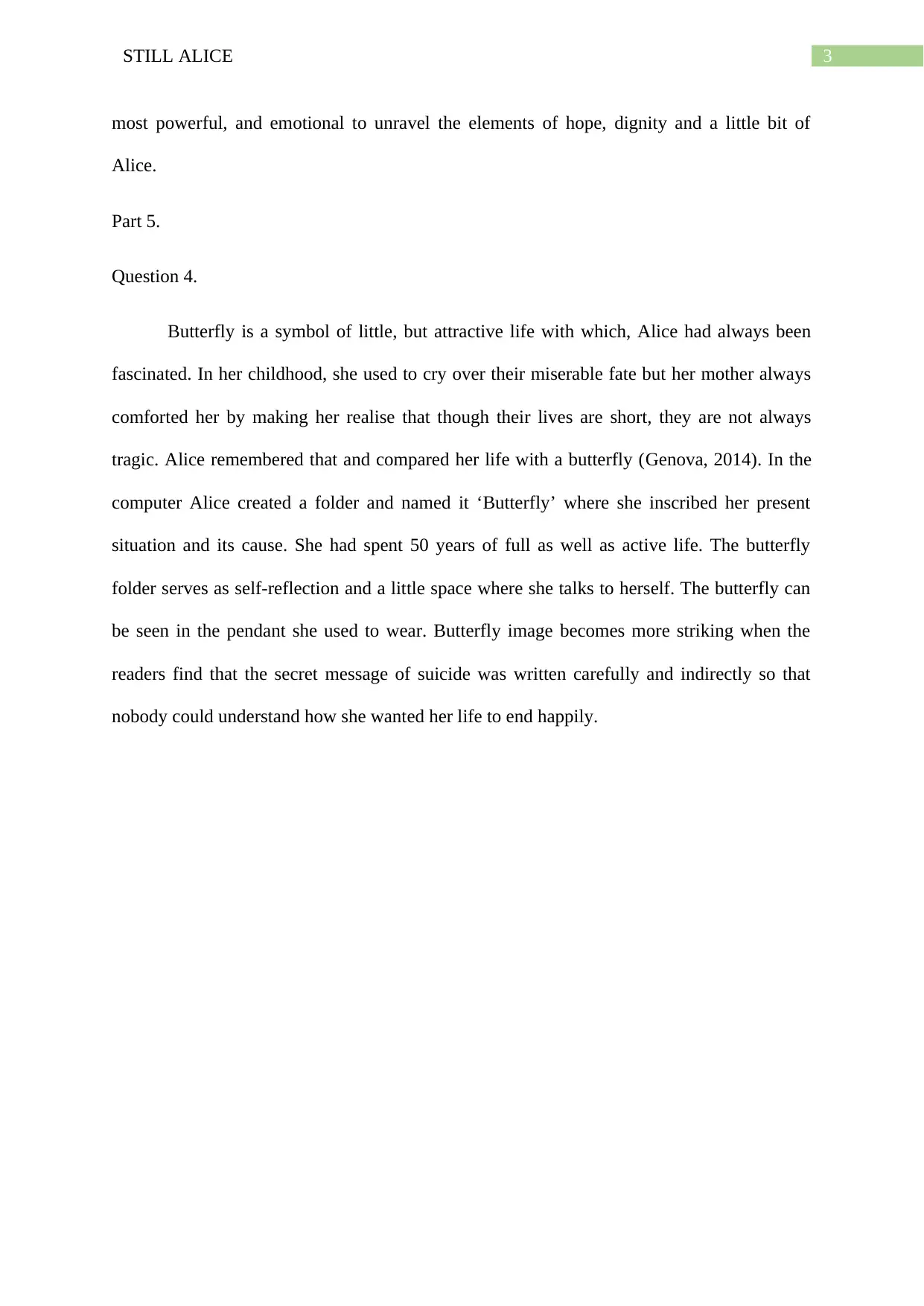
3STILL ALICE
most powerful, and emotional to unravel the elements of hope, dignity and a little bit of
Alice.
Part 5.
Question 4.
Butterfly is a symbol of little, but attractive life with which, Alice had always been
fascinated. In her childhood, she used to cry over their miserable fate but her mother always
comforted her by making her realise that though their lives are short, they are not always
tragic. Alice remembered that and compared her life with a butterfly (Genova, 2014). In the
computer Alice created a folder and named it ‘Butterfly’ where she inscribed her present
situation and its cause. She had spent 50 years of full as well as active life. The butterfly
folder serves as self-reflection and a little space where she talks to herself. The butterfly can
be seen in the pendant she used to wear. Butterfly image becomes more striking when the
readers find that the secret message of suicide was written carefully and indirectly so that
nobody could understand how she wanted her life to end happily.
most powerful, and emotional to unravel the elements of hope, dignity and a little bit of
Alice.
Part 5.
Question 4.
Butterfly is a symbol of little, but attractive life with which, Alice had always been
fascinated. In her childhood, she used to cry over their miserable fate but her mother always
comforted her by making her realise that though their lives are short, they are not always
tragic. Alice remembered that and compared her life with a butterfly (Genova, 2014). In the
computer Alice created a folder and named it ‘Butterfly’ where she inscribed her present
situation and its cause. She had spent 50 years of full as well as active life. The butterfly
folder serves as self-reflection and a little space where she talks to herself. The butterfly can
be seen in the pendant she used to wear. Butterfly image becomes more striking when the
readers find that the secret message of suicide was written carefully and indirectly so that
nobody could understand how she wanted her life to end happily.
Paraphrase This Document
Need a fresh take? Get an instant paraphrase of this document with our AI Paraphraser
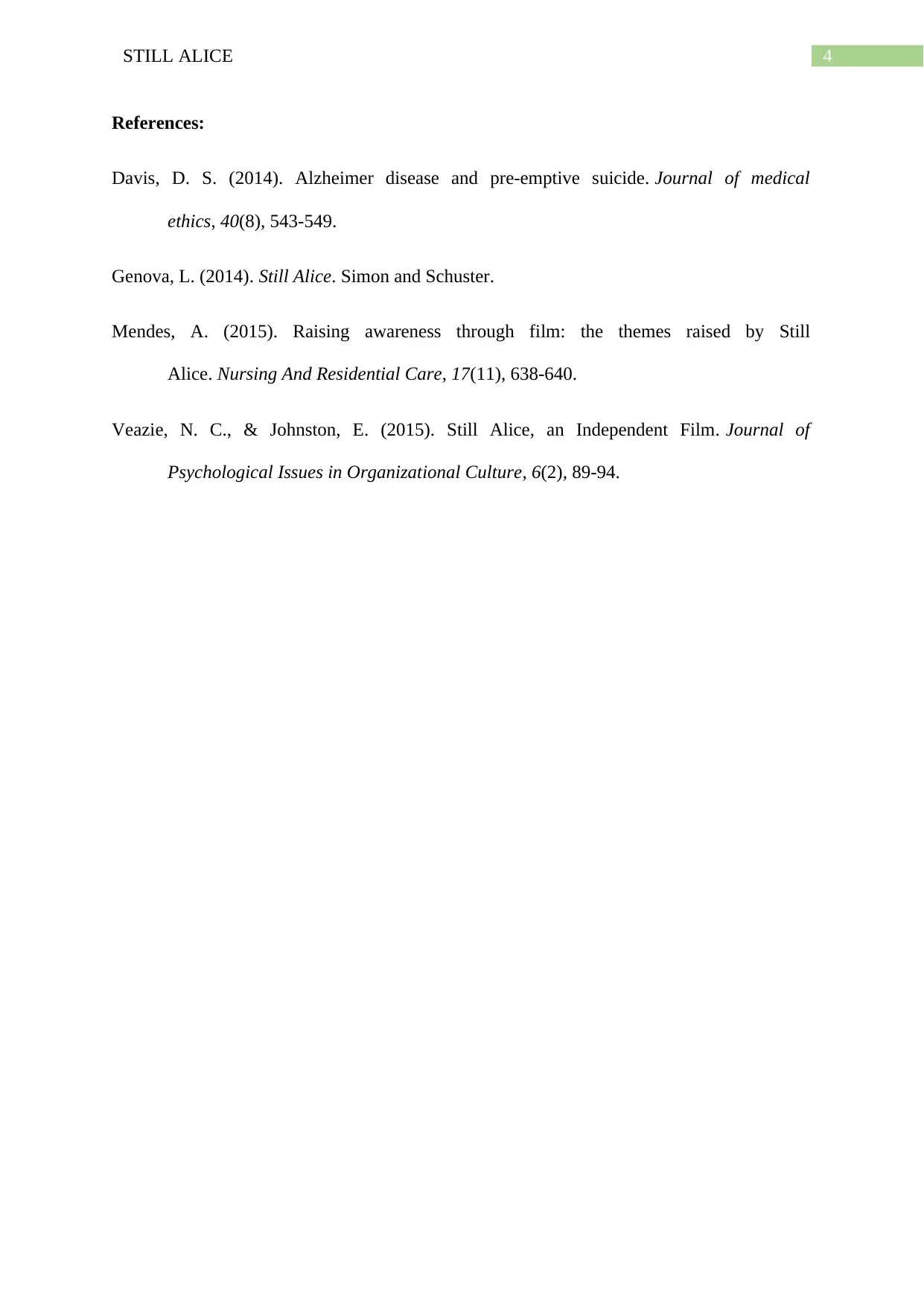
4STILL ALICE
References:
Davis, D. S. (2014). Alzheimer disease and pre-emptive suicide. Journal of medical
ethics, 40(8), 543-549.
Genova, L. (2014). Still Alice. Simon and Schuster.
Mendes, A. (2015). Raising awareness through film: the themes raised by Still
Alice. Nursing And Residential Care, 17(11), 638-640.
Veazie, N. C., & Johnston, E. (2015). Still Alice, an Independent Film. Journal of
Psychological Issues in Organizational Culture, 6(2), 89-94.
References:
Davis, D. S. (2014). Alzheimer disease and pre-emptive suicide. Journal of medical
ethics, 40(8), 543-549.
Genova, L. (2014). Still Alice. Simon and Schuster.
Mendes, A. (2015). Raising awareness through film: the themes raised by Still
Alice. Nursing And Residential Care, 17(11), 638-640.
Veazie, N. C., & Johnston, E. (2015). Still Alice, an Independent Film. Journal of
Psychological Issues in Organizational Culture, 6(2), 89-94.
1 out of 5
Related Documents
Your All-in-One AI-Powered Toolkit for Academic Success.
+13062052269
info@desklib.com
Available 24*7 on WhatsApp / Email
![[object Object]](/_next/static/media/star-bottom.7253800d.svg)
Unlock your academic potential
Copyright © 2020–2025 A2Z Services. All Rights Reserved. Developed and managed by ZUCOL.





